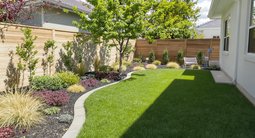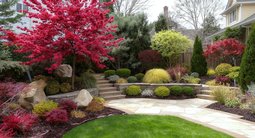TL;DR
Accidental mowing happens, even to the most intentional native landscaping. Here’s a rapid recovery plan, ways to prevent it from happening again, and simple design cues neighbors and crews understand. If you’re wondering how to restore a pollinator garden after mowing, focus on roots, seed bank, and spring timing.
Introduction

Resilient native perennials like asters and goldenrods often regrow when roots stay intact after mowing.
Most perennials will return if their crowns and roots remain intact, especially in USDA Zones 4–8 where asters, goldenrods, and native grasses are tough by design. Across the country, more homeowners are trading thirsty turf for native landscaping and no-mow yards. It’s better for water, soil, and pollinators, but there’s a new friction point: crews that mistake a wildflower meadow for an “overgrown lawn.” I’ve stood curbside with a homeowner in the Midwest, Zone 6b, watching a late-season meadow buzz one day and sit shorn the next. The garden felt silenced. The good news, horticulturists note, is that cutting isn’t the same as pulling. Here’s why that matters: if the stems were cut, not sprayed or ripped out, your pollinator garden is likely to rebound. Fall cuts mimic the graze, storm, or burn cycles prairies evolved with. Your job now is to stabilize the site, protect the habitat you have left, and make it crystal clear to anyone with a mower where not to mow.
Theme Overview
Clear signals and resilient plant choices are what keep a no-lawn landscape thriving even when people make mistakes. From tidy edges to native plant signage, this year’s backyard garden ideas center on communication as much as ecology. Think of it like trail markers for your front yard: house numbers visible from the street, “Native Habitat, Do Not Mow” signs, and a neat 18–24 inch mown border that frames the planting. Mix that with bulletproof perennials and grasses, and your eco-friendly yard becomes both beautiful and legible. Core keywords like native landscaping, curb appeal planting, and low-maintenance landscaping all point to the same truth: intention should be easy to read from the sidewalk.
Anecdote
Field note: On a Zone 6b street, a no-lawn front yard was mistakenly cut in October; by June the following year, asters and goldenrods returned fuller after a single spring cut to 10 inches and a light fall overseed.
Ideas, Tips, and Designs
01. The 48-Hour Rapid Recovery Plan What it is: A simple, time-boxed checklist to stabilize a cut garden and protect what remains. How it works: Within two days, document the damage (wide shots and close-ups), note whether plants were cut or pulled, and water once if weather is dry to deliver 0.5–1 inch to the root zone. Most meadow perennials store energy in roots by late summer, so a fall cut rarely kills them. Don’t rake; downed stems shelter overwintering insects and trap seed. If soil is exposed, top-dress bare patches with 0.5 inch of leaf mold or shredded leaves to prevent erosion. Most pollinator plants need at least six hours of direct sunlight for strong bloom cycles next year, so resist the urge to tarp or smother. How to try it:
- Photograph and email a short, factual summary to the crew for a written record.
- Deep water once if there’s no rain in 7 days.
- Spot-mulch bare soil with shredded leaves, not bark.
- Mount 4–6 inch reflective numbers near the door and on the mailbox.
- Stake a discrete “Do Not Spray/Do Not Mow” sign at front corners.
- Keep a 24 inch mown strip along sidewalks for instant curb appeal.
- Scratch-broadcast natives suited to your USDA zone.
- Cover lightly with clean straw at 1 bale per 1,000 sq ft.
- Mark zones with flags so no one “helps” by raking.
- Plant 5–7 little bluestem in a drift 2 feet apart.
- Add two serviceberries 5 feet off the walk for structure.
- Leave stems 12–18 inches over winter for insect habitat.
- Flag the surveyed line, then plant 18 inches inside it.
- Use one species in a tidy hedge to simplify maintenance.
- Install two “Do Not Mow Beyond This Edge” markers.
- Post a polite “Please knock before any yard work here” sign.
- Outline beds with 6–8 inch steel or stone edging.
- Stake corners with bright ribbon during peak bloom.
- Cut some stems to 18 inches to create nesting tubes.
- Rake leaves into beds, not bags.
- Keep brush piles away from foundations and wood siding.
- Send a one-page summary with photos and a simple ask.
- Request plant credits at a local native nursery, not chemicals.
- Schedule a spring walkthrough to verify regrowth.
- Late March: cut to 10 inches; leave debris as mulch if pest-free.
- May–June: spot-weed for 15 minutes every other week.
- July: overseed gaps after a rain with 1/8 inch soil contact.
- Cut a clean 24 inch path through the planting to the door.
- Install a 4–6 inch stone or steel edging band.
- Repeat one groundcover at the front lip for order.
Transitional Reflection
The beauty of modern gardening isn’t precision, it’s participation. Every stem you leave for a bee, every sign that protects a corner of habitat, becomes a quiet contract with your place. I’ve watched cut meadows roar back in June with stronger roots and thicker bloom, especially where gardeners stayed patient and practical. Think of setbacks as a controlled burn nature didn’t schedule. Your job is to guide the rebound and make the story easy to read from the street.
How to Visualize It
Before you plant or replant a single seed, map your space virtually. Platforms like ReimagineHome let you preview garden layouts, sunlight paths, mown edges, and color palettes—turning ideas into a living blueprint. Upload a photo, experiment with native plant palettes, and add a mown border or signage placements on-screen so your vision is clear long before the first trowel hits soil.
Visualization Scenario
Upload a photo of your front yard to ReimagineHome, add a 24 inch mown border, place two “Native Habitat” signs at the approaches, and test plant groupings (3–5 of each) to see how the matrix reads from the sidewalk.
FAQ
How do you restore a pollinator garden after it was mowed? Most perennials recover if roots weren’t pulled; document damage, water once if dry (0.5–1 inch), avoid raking, and dormant-seed bare spots. Will asters and goldenrods come back after being cut to the ground? Yes, these perennials resprout from crowns in spring if not uprooted or sprayed; leave stems 12–18 inches over winter for insect habitat. When is the best time to cut a meadow-style native garden? Designers recommend a single cut in late winter or very early spring to 8–12 inches, which preserves winter habitat and protects early nesting pollinators. How can I prevent landscapers from mowing a native yard by mistake? Use 4–6 inch house numbers, “No Mow – Pollinator Habitat” signs at property edges, a 24 inch mown border, and clear property-line markers. What are the best low-maintenance plants for small front yards? Try little bluestem, switchgrass, coneflower, black-eyed Susan, and dwarf aronia; space 18–24 inches apart and give at least six hours of direct sun. Should I accept compensation now or wait until spring? Experts recommend documenting promptly and accepting reasonable remedies now (plant credits, mulch, timeline) while reserving a spring check-in in writing.
Closing Reflection
Gardens are resilient when their roots and stories are strong. If your native front yard was mistakenly cut, stabilize it, communicate clearly, and lean on plants bred by evolution to bounce back. Asters will purple again, goldenrod will glow, bees will find hollow stems, and your neighbors will see intention in the way you edge and sign the space. In 2025, the modern gardener grows more than plants—they grow understanding, resilience, and a patch of earth that feels like home. When you’re ready to imagine the comeback, sketch it digitally with ReimagineHome and walk into spring with a plan.
.svg)

.svg)














.png)